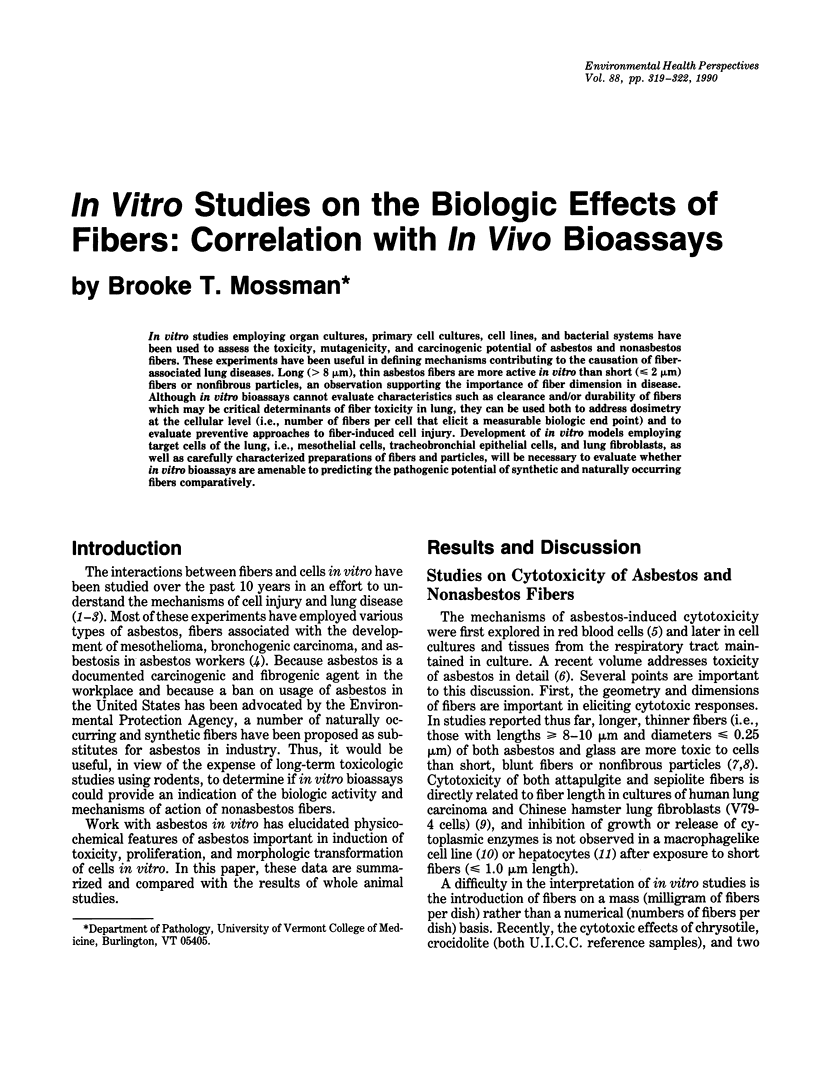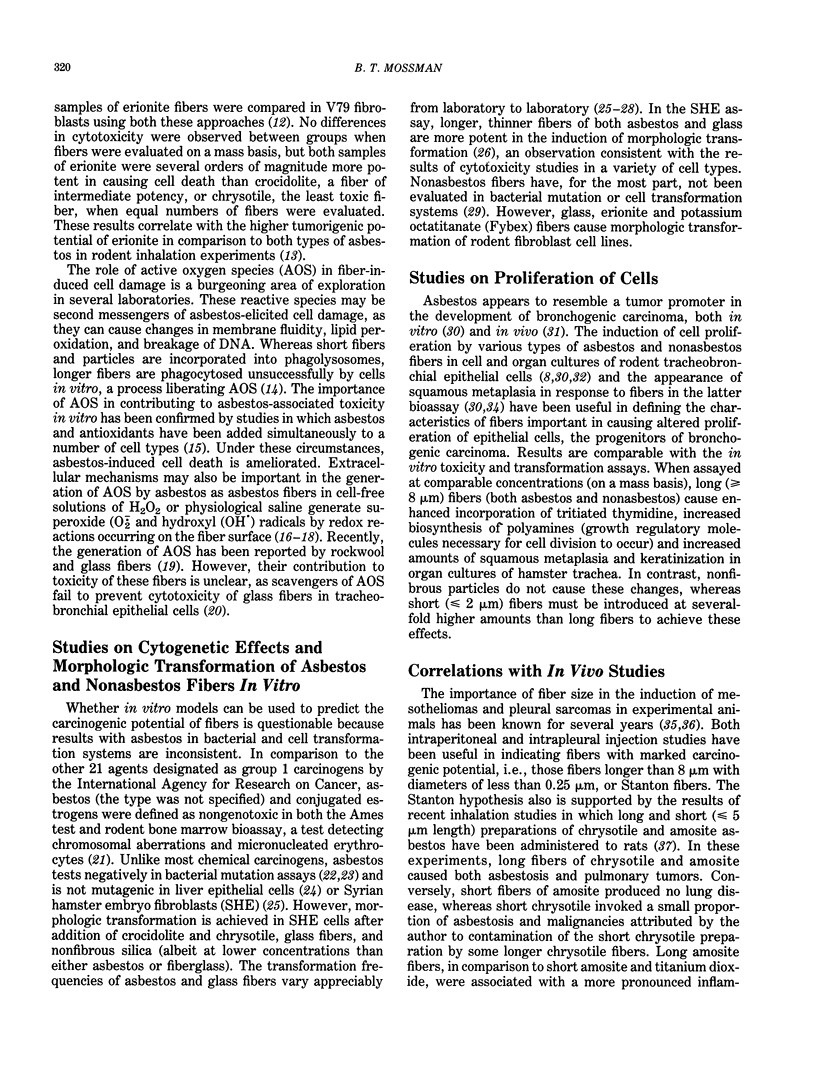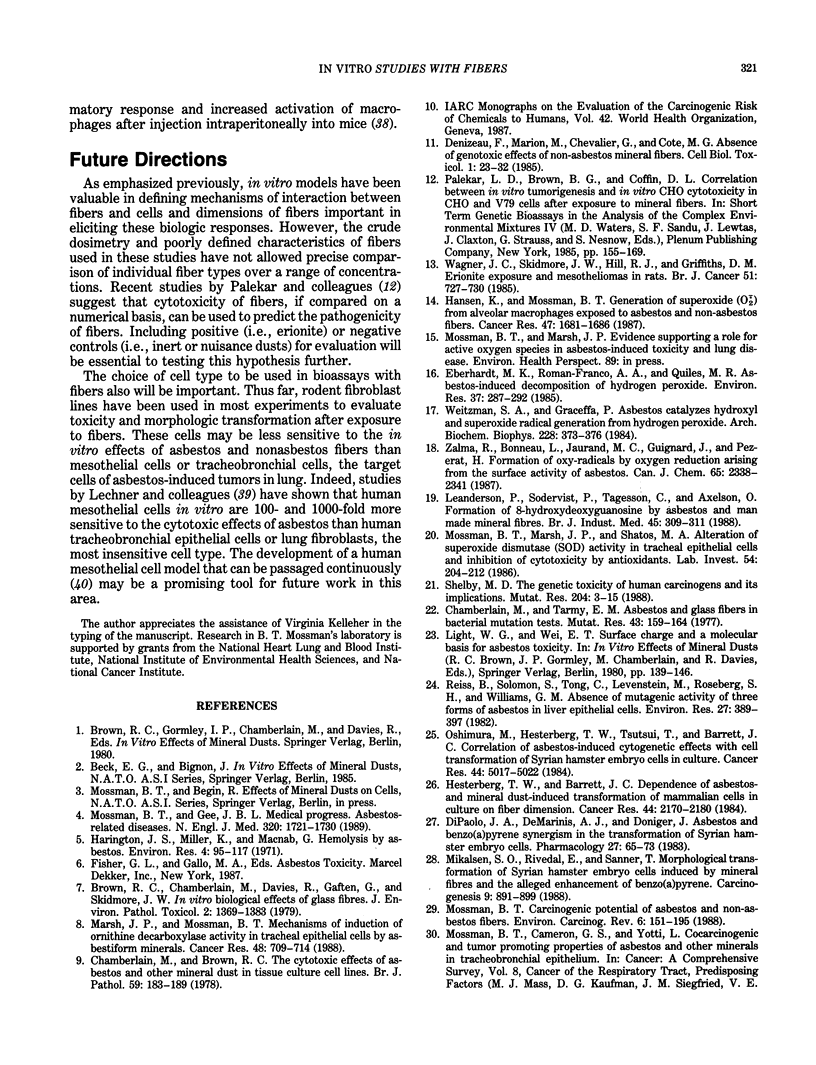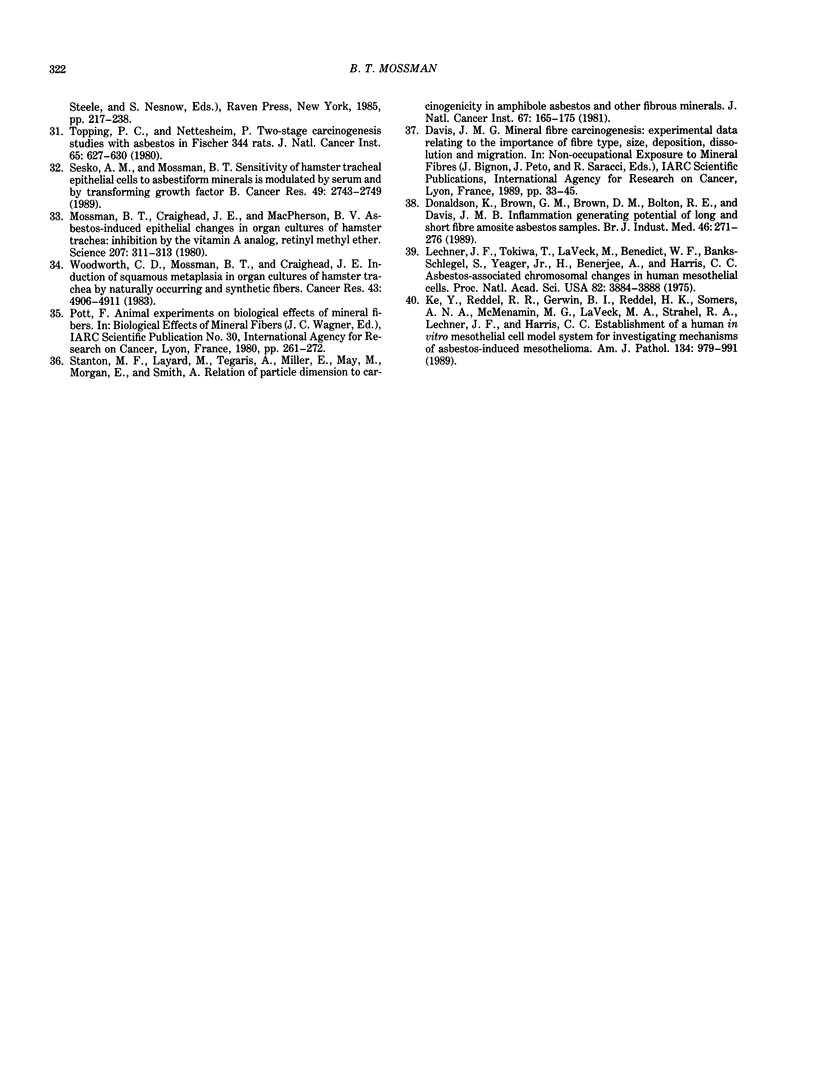Abstract
In vitro studies employing organ cultures, primary cell cultures, cell lines, and bacterial systems have been used to assess the toxicity, mutagenicity, and carcinogenic potential of asbestos and nonasbestos fibers. These experiments have been useful in defining mechanisms contributing to the causation of fiber-associated lung diseases. Long (greater than 8 microns), thin asbestos fibers are more active in vitro than short (less than or equal to 2 microns) fibers or nonfibrous particles, an observation supporting the importance of fiber dimension in disease. Although in vitro bioassays cannot evaluate characteristics such as clearance and/or durability of fibers which may be critical determinants of fiber toxicity in lung, they can be used both to address dosimetry at the cellular level (i.e., number of fibers per cell that elicit a measurable biologic end point) and to evaluate preventive approaches to fiber-induced cell injury. Development of in vitro models employing target cells of the lung, i.e., mesothelial cells, tracheobronchial epithelial cells, and lung fibroblasts, as well as carefully characterized preparations of fibers and particles, will be necessary to evaluate whether in vitro bioassays are amenable to predicting the pathogenic potential of synthetic and naturally occurring fibers comparatively.
Full text
PDF



Selected References
These references are in PubMed. This may not be the complete list of references from this article.
- Brown R. C., Chamberlain M., Davies R., Gaffen J., Skidmore J. W. In vitro biological effects of glass fibers. J Environ Pathol Toxicol. 1979 Jul-Aug;2(6):1369–1383. [PubMed] [Google Scholar]
- Chamberlain M., Brown R. C. The cytotoxic effects of asbestos and other mineral dust in tissue culture cell lines. Br J Exp Pathol. 1978 Apr;59(2):183–189. [PMC free article] [PubMed] [Google Scholar]
- Chamberlain M., Tarmy E. M. Asbestos and glass fibres in bacterial mutation tests. Mutat Res. 1977 May;43(2):159–164. doi: 10.1016/0027-5107(77)90001-x. [DOI] [PubMed] [Google Scholar]
- Davis J. M. Mineral fibre carcinogenesis: experimental data relating to the importance of fibre type, size, deposition, dissolution and migration. IARC Sci Publ. 1989;(90):33–45. [PubMed] [Google Scholar]
- Denizeau F., Marion M., Chevalier G., Cote M. G. Absence of genotoxic effects of nonasbestos mineral fibers. Cell Biol Toxicol. 1985 Jan;1(2):23–32. doi: 10.1007/BF00717788. [DOI] [PubMed] [Google Scholar]
- DiPaolo J. A., DeMarinis A. J., Doniger J. Asbestos and benzo(a)pyrene synergism in the transformation of Syrian hamster embryo cells. Pharmacology. 1983;27(2):65–73. doi: 10.1159/000137837. [DOI] [PubMed] [Google Scholar]
- Donaldson K., Brown G. M., Brown D. M., Bolton R. E., Davis J. M. Inflammation generating potential of long and short fibre amosite asbestos samples. Br J Ind Med. 1989 Apr;46(4):271–276. doi: 10.1136/oem.46.4.271. [DOI] [PMC free article] [PubMed] [Google Scholar]
- Eberhardt M. K., Román-Franco A. A., Quiles M. R. Asbestos-induced decomposition of hydrogen peroxide. Environ Res. 1985 Aug;37(2):287–292. doi: 10.1016/0013-9351(85)90108-2. [DOI] [PubMed] [Google Scholar]
- Hansen K., Mossman B. T. Generation of superoxide (O2-.) from alveolar macrophages exposed to asbestiform and nonfibrous particles. Cancer Res. 1987 Mar 15;47(6):1681–1686. [PubMed] [Google Scholar]
- Harington J. S., Miller K., Macnab G. Hemolysis by asbestos. Environ Res. 1971 Apr;4(2):95–117. doi: 10.1016/0013-9351(71)90038-7. [DOI] [PubMed] [Google Scholar]
- Hesterberg T. W., Barrett J. C. Dependence of asbestos- and mineral dust-induced transformation of mammalian cells in culture on fiber dimension. Cancer Res. 1984 May;44(5):2170–2180. [PubMed] [Google Scholar]
- Ke Y., Reddel R. R., Gerwin B. I., Reddel H. K., Somers A. N., McMenamin M. G., LaVeck M. A., Stahel R. A., Lechner J. F., Harris C. C. Establishment of a human in vitro mesothelial cell model system for investigating mechanisms of asbestos-induced mesothelioma. Am J Pathol. 1989 May;134(5):979–991. [PMC free article] [PubMed] [Google Scholar]
- Leanderson P., Söderkvist P., Tagesson C., Axelson O. Formation of 8-hydroxydeoxyguanosine by asbestos and man made mineral fibres. Br J Ind Med. 1988 May;45(5):309–311. doi: 10.1136/oem.45.5.309. [DOI] [PMC free article] [PubMed] [Google Scholar]
- Lechner J. F., Tokiwa T., LaVeck M., Benedict W. F., Banks-Schlegel S., Yeager H., Jr, Banerjee A., Harris C. C. Asbestos-associated chromosomal changes in human mesothelial cells. Proc Natl Acad Sci U S A. 1985 Jun;82(11):3884–3888. doi: 10.1073/pnas.82.11.3884. [DOI] [PMC free article] [PubMed] [Google Scholar]
- Marsh J. P., Mossman B. T. Mechanisms of induction of ornithine decarboxylase activity in tracheal epithelial cells by asbestiform minerals. Cancer Res. 1988 Feb 1;48(3):709–714. [PubMed] [Google Scholar]
- Mikalsen S. O., Rivedal E., Sanner T. Morphological transformation of Syrian hamster embryo cells induced by mineral fibres and the alleged enhancement of benzo[a]pyrene. Carcinogenesis. 1988 Jun;9(6):891–899. doi: 10.1093/carcin/9.6.891. [DOI] [PubMed] [Google Scholar]
- Mossman B. T., Craighead J. E., MacPherson B. V. Asbestos-induced epithelial changes in organ cultures of hamster trachea: inhibition by retinyl methyl ether. Science. 1980 Jan 18;207(4428):311–313. doi: 10.1126/science.7350661. [DOI] [PubMed] [Google Scholar]
- Mossman B. T., Gee J. B. Asbestos-related diseases. N Engl J Med. 1989 Jun 29;320(26):1721–1730. doi: 10.1056/NEJM198906293202604. [DOI] [PubMed] [Google Scholar]
- Mossman B. T., Marsh J. P., Shatos M. A. Alteration of superoxide dismutase activity in tracheal epithelial cells by asbestos and inhibition of cytotoxicity by antioxidants. Lab Invest. 1986 Feb;54(2):204–212. [PubMed] [Google Scholar]
- Oshimura M., Hesterberg T. W., Tsutsui T., Barrett J. C. Correlation of asbestos-induced cytogenetic effects with cell transformation of Syrian hamster embryo cells in culture. Cancer Res. 1984 Nov;44(11):5017–5022. [PubMed] [Google Scholar]
- Reiss B., Solomon S., Tong C., Levenstein M., Rosenberg S. H., Williams G. M. Absence of mutagenic activity of three forms of asbestos in liver epithelial cells. Environ Res. 1982 Apr;27(2):389–397. doi: 10.1016/0013-9351(82)90094-9. [DOI] [PubMed] [Google Scholar]
- Sesko A. M., Mossman B. T. Sensitivity of hamster tracheal epithelial cells to asbestiform minerals modulated by serum and by transforming growth factor beta 1. Cancer Res. 1989 May 15;49(10):2743–2749. [PubMed] [Google Scholar]
- Shelby M. D. The genetic toxicity of human carcinogens and its implications. Mutat Res. 1988 Jan;204(1):3–15. doi: 10.1016/0165-1218(88)90113-9. [DOI] [PubMed] [Google Scholar]
- Topping D. C., Nettesheim P. Two-stage carcinogenesis studies with asbestos in Fischer 344 rats. J Natl Cancer Inst. 1980 Sep;65(3):627–630. [PubMed] [Google Scholar]
- Wagner J. C., Skidmore J. W., Hill R. J., Griffiths D. M. Erionite exposure and mesotheliomas in rats. Br J Cancer. 1985 May;51(5):727–730. doi: 10.1038/bjc.1985.108. [DOI] [PMC free article] [PubMed] [Google Scholar]
- Weitzman S. A., Graceffa P. Asbestos catalyzes hydroxyl and superoxide radical generation from hydrogen peroxide. Arch Biochem Biophys. 1984 Jan;228(1):373–376. doi: 10.1016/0003-9861(84)90078-x. [DOI] [PubMed] [Google Scholar]
- Woodworth C. D., Mossman B. T., Craighead J. E. Induction of squamous metaplasia in organ cultures of hamster trachea by naturally occurring and synthetic fibers. Cancer Res. 1983 Oct;43(10):4906–4912. [PubMed] [Google Scholar]


